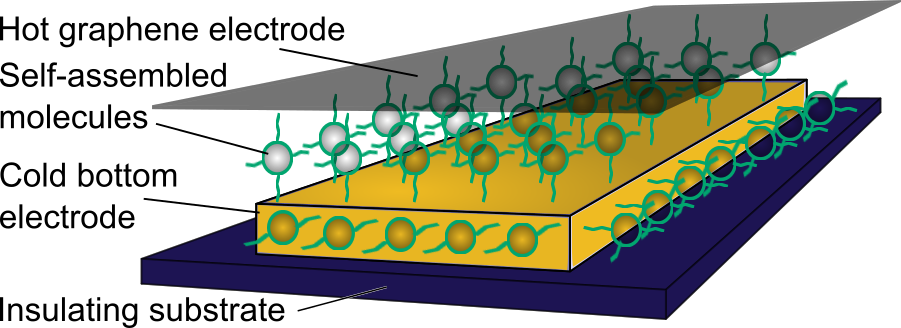Electrically Contacting Molecules Using Graphene for Energy Harvesting, Memristors, etc
Short rigid molecules can now be tailored to have particular electrical and thermal properties. A self-assembled monolayer (SAM) of such molecules could therefore generate electrical power from a temperature gradient across it, “harvesting” waste energy from the environment. The challenge is to contact the top of the monolayer without shorting through to the other electrode. This project will extend our recent work with 5nm nanocrystals to contact molecules deposited on a gold electrode with a graphene electrode lowered on top of them, forming a sandwich structure in which the electrodes are kept apart by the molecules, even though they are just a few nm long. Heat will be applied to the graphene electrode and the voltage generated will be measured. This will require the development of sophisticated device fabrication and measurement techniques. The molecules will be made in Durham with theoretical support from Lancaster. Many aspects of the junctions can be varied to test the physics of device operation and optimise efficiency, and to explore new possibilities, such as superconducting or ferromagnetic electrodes or 2D materials other than graphene.

We have been exploring many electrical properties and applications of these molecular junctions, as well as demonstrating interesting physics where molecules or nanocrystals behave as quantum dots and exhibit Coulomb blockade, at cryogenic temperatures and sometimes even at room temperature. With our collaborators, we plan to make molecules that can be programmed to have a certain resistance by applying a programming voltage, so-called memristors. This can form the basis of a "neuromorphic" device, as needed for machine learning and AI, where the strength of the connections in the neural network is represented by an array of memristors. This could lead to neural processing units that use far less power than at present. A PhD project could include fabrication and measurements of these devices, and testing of their memristive and neuromorphic properties.
Applicants should demonstrate an understanding of semiconductor physics and quantum mechanics.
For more information, please contact Prof Chris Ford.
